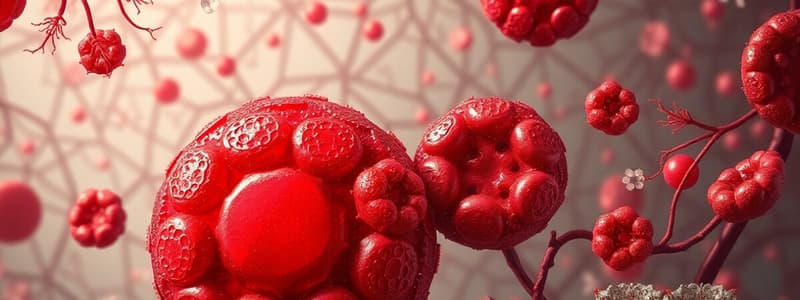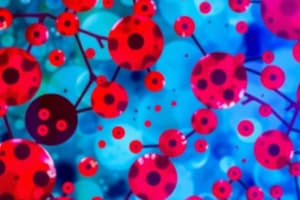Podcast
Questions and Answers
What is the primary function of erythropoietin (EPO) in blood cell development?
What is the primary function of erythropoietin (EPO) in blood cell development?
- It stimulates the development of erythroid precursors. (correct)
- It promotes the maturation of megakaryocytes.
- It inhibits the differentiation of progenitor cells.
- It regulates the survival of lymphocytes.
Which cell types are known to produce Interleukin 1 (IL-1) and Interleukin 2 (IL-2)?
Which cell types are known to produce Interleukin 1 (IL-1) and Interleukin 2 (IL-2)?
- T-lymphocytes and fibroblasts only.
- Endothelial cells and erythroid precursors.
- Only macrophages and fibroblasts.
- Macrophages, activated T-lymphocytes, fibroblasts, and endothelial cells. (correct)
What could be inferred if a patient has low levels of erythropoietin (EPO) in their blood?
What could be inferred if a patient has low levels of erythropoietin (EPO) in their blood?
- The patient is likely experiencing secondary polycythemia.
- The patient has an overactive immune response.
- The patient may have anemia or kidney disease/dysfunction. (correct)
- The patient is producing more red blood cells than normal.
Which of the following best describes the role of cytokines like IL-1 and IL-2 in blood cell development?
Which of the following best describes the role of cytokines like IL-1 and IL-2 in blood cell development?
What therapeutic applications are associated with erythropoietin (EPO)?
What therapeutic applications are associated with erythropoietin (EPO)?
What is the average blood volume in an adult?
What is the average blood volume in an adult?
What is the weight percentage of proteins in the plasma portion of blood?
What is the weight percentage of proteins in the plasma portion of blood?
Which of the following blood cells is primarily responsible for fighting infection?
Which of the following blood cells is primarily responsible for fighting infection?
Which component of blood is responsible for respiratory gas exchange?
Which component of blood is responsible for respiratory gas exchange?
Which type of white blood cell is primarily involved in humoral immunity?
Which type of white blood cell is primarily involved in humoral immunity?
What is the main function of neutrophils?
What is the main function of neutrophils?
How is blood composition generally divided?
How is blood composition generally divided?
What can cause a pathological condition in blood cell formation?
What can cause a pathological condition in blood cell formation?
Which of the following is a key component of the plasma in blood?
Which of the following is a key component of the plasma in blood?
What is an important function of platelets?
What is an important function of platelets?
What is the N:C ratio of a pronormoblast?
What is the N:C ratio of a pronormoblast?
Which characteristic helps differentiate a basophilic normoblast from a pronormoblast?
Which characteristic helps differentiate a basophilic normoblast from a pronormoblast?
What is the approximate size of a basophilic normoblast?
What is the approximate size of a basophilic normoblast?
How long does it take for basophilic normoblasts to develop?
How long does it take for basophilic normoblasts to develop?
What percentage of bone marrow comprises pronormoblasts?
What percentage of bone marrow comprises pronormoblasts?
What is the predominant color of the cytoplasm in a basophilic normoblast?
What is the predominant color of the cytoplasm in a basophilic normoblast?
How many times more basophilic normoblasts are present in normal bone marrow compared to pronormoblasts?
How many times more basophilic normoblasts are present in normal bone marrow compared to pronormoblasts?
Which of the following describes nucleoli in a basophilic normoblast?
Which of the following describes nucleoli in a basophilic normoblast?
What defines committed hematopoietic progenitor cells?
What defines committed hematopoietic progenitor cells?
Where does intramedullary hematopoiesis occur?
Where does intramedullary hematopoiesis occur?
What is the function of sinusoids in the context of hematopoiesis?
What is the function of sinusoids in the context of hematopoiesis?
Which of the following statements about the internal structure of bone marrow is true?
Which of the following statements about the internal structure of bone marrow is true?
What general trend is observed regarding cell size as hematopoietic cells mature?
What general trend is observed regarding cell size as hematopoietic cells mature?
What is the primary role of granulocytes in hematopoiesis?
What is the primary role of granulocytes in hematopoiesis?
Which hematopoietic cell type is released directly into the sinusoidal blood?
Which hematopoietic cell type is released directly into the sinusoidal blood?
What characteristic does NOT apply to committed hematopoietic progenitor cells?
What characteristic does NOT apply to committed hematopoietic progenitor cells?
What is a distinguishing feature of blood cell development in hemopoietic cords?
What is a distinguishing feature of blood cell development in hemopoietic cords?
Which statement about hematopoietic tissue is incorrect?
Which statement about hematopoietic tissue is incorrect?
What is the percentage range of orthochromatic normoblasts in normal bone marrow?
What is the percentage range of orthochromatic normoblasts in normal bone marrow?
Where can orthochromatic normoblasts be found in the human body?
Where can orthochromatic normoblasts be found in the human body?
What describes the appearance of the nucleus of an orthochromatic normoblast?
What describes the appearance of the nucleus of an orthochromatic normoblast?
What is the typical size range of orthochromatic normoblasts?
What is the typical size range of orthochromatic normoblasts?
What happens to the nucleus of an orthochromatic normoblast during erythrocyte development?
What happens to the nucleus of an orthochromatic normoblast during erythrocyte development?
Flashcards are hidden until you start studying
Study Notes
Hematology Overview
- Hematology: study of blood and blood-forming organs, focusing on blood cells and coagulation factors.
- Blood composition: approximately 55% plasma and 45% blood cells (WBCs, RBCs, PLTs).
Blood Volume
- Average adult blood volume: 4-6 liters.
- Average male: 5-6 liters, female: 4-5 liters.
Plasma Composition
- Plasma is mainly water (90-92%).
- Contains proteins (7%): albumin, globulin, fibrinogen.
- Organic constituents include urea, creatinine, glucose; inorganic constituents include sodium, potassium, calcium, chloride.
- Also contains respiratory gases and internal secretions like enzymes, hormones, and antibodies (immunoglobulins).
Blood Cell Types
- Major blood cells include erythrocytes (RBCs), leukocytes (WBCs), and thrombocytes (PLTs).
- Subtypes of leukocytes: neutrophils, eosinophils, basophils, and lymphocytes.
Blood Cell Functions
- Granulocytes (neutrophils, eosinophils, basophils): involved in fighting infections and immune responses.
- Lymphocytes: responsible for cellular and humoral immunity, including antibody production.
- Monocytes: phagocytosis and cytokine secretion.
- Erythrocytes: primarily involved in respiratory gas exchange (O2 and CO2).
- Platelets: critical in hemostasis (blood clotting).
Hematopoiesis Regulation
- Balance between cell formation and aging/destruction is vital for health.
- Disturbances can lead to pathological conditions.
- Interleukins (IL-1, IL-2) regulate blood cell development and function.
Erythropoietin (EPO)
- EPO is a growth factor produced mainly by the kidneys, critical for RBC growth and differentiation.
- Low EPO indicates anemia or kidney dysfunction; high EPO suggests secondary polycythemia.
- EPO-enhancing drugs available for therapy (e.g., Epoetin, Procrit).
Hematopoietic Progenitor Cells
- Stem cells develop into distinct blood cell lineages.
- Committed cells develop into specific cell types.
Hematopoietic Tissue
- Hematopoiesis occurs within the bone marrow.
- Cells travel through sinusoids in bone marrow to enter the bloodstream.
Cellular Characteristics in Maturation
- Overall size decreases for WBCs, RBCs, and PLTs during maturation; megakaryocytes are an exception.
- Pronormoblast: earliest recognizable RBC precursor; size 14-24 microns with a high nucleocytoplasmic ratio.
Normoblast Development
- Basophilic normoblasts (daughter cells of pronormoblasts) appear in higher numbers than pronormoblasts; they resume RNA and hemoglobin accumulation upon maturation.
- Orthochromic normoblasts can be identified by their distinctive characteristics like pyknotic nucleus and specific cytoplasmic content.
Reticulocyte Formation
- The reticulocyte is formed after the nucleus from an orthochromatic normoblast is extruded, containing RNA and about two-thirds of total hemoglobin content.
Studying That Suits You
Use AI to generate personalized quizzes and flashcards to suit your learning preferences.




